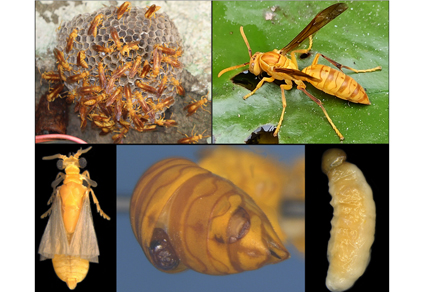Abstract
We report the morphology, biology and phylogeny of a new strepsipteran endoparasitic species: Xenos gadagkari, which stylopises the primitively eusocial wasp Polistes wattii from Punjab, India. We report a high abundance of the endoparasite in P. wattii population of our study area and provide the morphological description of adult males, male puparium and neotenic females. This species is sufficiently different from other species of Xenos reported from social wasps and therefore, constitutes a new species, X. gadagkari Sen and Nain, sp. nov. Although there are a few reports of strepsipteran parasitoids from India, this is the first confirmed report with a description of a Xenos species from the Indian population of P. wattii. Our findings contribute to the growing body of knowledge on Xenos and provide a foundation for future behavioural, microbial and molecular studies on this enigmatic group of insects.
References
- Beani, L., Dallai, R., Mercati, D., Cappa, F., Giusti, F. & Manfredini, F. (2011) When a parasite breaks all the rules of a colony: Morphology and fate of wasps infected by a strepsipteran endoparasite. Animal Behaviour, 82 (6), 1305–1312. https://doi.org/10.1016/j.anbehav.2011.09.012
- Beani, L. & Massolo, A. (2007) Polistes dominulus wasps (Hymenoptera Vespidae), if parasitized by Xenos vesparum (Strepsiptera Stylopidae), wander among nests during the pre-emergence phase. Redia, 90, 161–164.
- Benda, D., Pohl, H., Nakase, Y., Beutel, R. & Straka, J. (2022) A generic classification of Xenidae (Strepsiptera) based on the morphology of the female cephalothorax and male cephalotheca with a preliminary checklist of species. ZooKeys, 1093, 1–134. https://doi.org/10.3897/zookeys.1093.72339
- Benda, D., Votýpková, K., Nakase, Y. & Straka, J. (2021) Unexpected cryptic species diversity of parasites of the family Xenidae (Strepsiptera) with a constant diversification rate over time. Systematic Entomology, 46 (1), 252–265. https://doi.org/10.1111/syen.12460
- Dapporto, L., Cini, A., Palagi, E., Morelli, M., Simonti, A. & Turillazzi, S. (2007) Behaviour and chemical signature of pre-hibernating females of Polistes dominulus infected by the strepsipteran Xenos vesparum. Parasitology, 134 (4), 545–552. https://doi.org/10.1017/S0031182006001739
- Dong, Z., Liu, X., Mao, C., He, J. & Li, X. (2022) Xenos yangi sp. nov.: A new twisted-wing parasite species (Strepsiptera, Xenidae) from Gaoligong Mountains, Southwest China. ZooKeys, 1085, 11–27. https://doi.org/10.3897/zookeys.1085.76484
- Geffre, A.C., Liu, R., Manfredini, F., Beani, L., Kathirithamby, J., Grozinger, C.M., Toth, A.L., Geffre, A.C. & Toth, A.L. (2017) Transcriptomics of an extended phenotype : parasite manipulation of wasp social behaviour shifts expression of caste-related genes. Proceedings of the Royal Society London B, 284 (1852), 20170029. https://doi.org/10.1098/rspb.2017.0029
- Green, E. (1912) Strepsiptera in India. Nature, 89, 632. https://doi.org/10.1038/089632a0
- Hall, T.A. (1999) BioEdit: a user-friendly biological sequence alignment editor and analysis program for Windows 95/98/NT. In Nucleic Acids Symposium Series, 41, 95–98.
- Hughes, D. (2002) The value of a broad mind: Some natural history meanderings of Bill Hamilton. Ethology Ecology and Evolution, 14 (2), 83–89. https://doi.org/10.1080/08927014.2002.9522747
- Hughes, D.P., Beani, L., Turillazzi, S. & Kathirithamby, J. (2003) Prevalence of the parasite Strepsiptera in Polistes as detected by dissection of immatures. Insectes Sociaux, 50 (1), 62–68. https://doi.org/10.1007/s000400300010
- Hughes, D.P., Kathirithamby, J., Turillazzi, S. & Beani, L. (2004a) Social wasps desert the colony and aggregate outside if parasitized: Parasite manipulation? Behavioral Ecology, 15 (6), 1037–1043. https://doi.org/10.1093/beheco/arh111
- Hughes, D.P., Kathirithamby, J. & Beani, L. (2004b) Prevalence of the parasite Strepsiptera in adult Polistes wasps: Field collections and literature overview. Ethology Ecology and Evolution, 16 (4), 363–375. https://doi.org/10.1080/08927014.2004.9522627
- Kathirithamby, J. (1989) Review of the Order Strepsiptera. Systematic Entomology, 14 (1), 41–92. https://doi.org/10.1111/j.1365-3113.1989.tb00265.x
- Kathirithamby, J. (2024) World Strepsiptera Database. Accessed at https://strepsiptera.aphia.org (accessed 26 June 2024) https://doi.org/10.14284/484
- Kathirithamby, J. (2009) Host-parasitoid associations in Strepsiptera. Annual Review of Entomology, 54, 227–249. https://doi.org/10.1146/annurev.ento.54.110807.090525
- Kathirithamby, J. & Hughes, D.P. (2006) Description and biological notes of the first species of Xenos (Strepsiptera: Stylopidae) parasitic in Polistes carnifex F. (Hymenoptera: Vespidae) in Mexico. Zootaxa, 1104 (1), 35–45. https://doi.org/10.11646/zootaxa.1104.1.3
- Kifune, T. & Maeta, Y. (1985) Taxonomical Studies on the Genus Xenos (Strepsiptera, Stylopidae) Parasitic on Vespa and Polistes (Hymenoptera, Vespidae) of Taiwan with Descriptions of Three New Species. Konytu, Tokyo, 53, 426–435.
- Kinzelbach, R.K. (1978) Strepsiptera. Vol. 1. Veb Gustav Fisher Verlag Jena, 166 pp.
- Kumar, S., Stecher, G. & Tamura, K. (2016) MEGA7: Molecular Evolutionary Genetics Analysis Version 7.0 for Bigger Datasets. Molecular Biology and Evolution, 33 (7), 1870–1874. https://doi.org/10.1093/molbev/msw054
- Nain, D. & Sen, R. (2023) A Review of Our Meagre Knowledge of Asian Polistes, and a Call for More Studies. Journal of the Indian Institute of Science, 103 (4), 1049–1064. https://doi.org/10.1007/s41745-023-00402-8
- Richter, A., Wipfler, B., Beutel, R.G. & Pohl, H. (2017) The female cephalothorax of Xenos vesparum Rossi, 1793 (Strepsiptera: Xenidae). Arthropod Systematics and Phylogeny, 75 (2), 327–347. https://doi.org/10.3897/asp.75.e31910
- Ronquist, F., Teslenko, M., Van Der Mark, P., Ayres, D.L., Darling, A., Höhna, S., Larget, B., Liu, L., Suchard, M.A. & Huelsenbeck, J.P. (2012) Mrbayes 3.2: Efficient bayesian phylogenetic inference and model choice across a large model space. Systematic Biology, 61 (3), 539–542. https://doi.org/10.1093/sysbio/sys029
- Rozas, J., Ferrer-Mata, A., Sánchez-DelBarrio, J.C., Guirao-Rico, S., Librado, P., Ramos-Onsins, S.E. & Sánchez-Gracia, A. (2017) DnaSP 6: DNA Sequence Polymorphism Analysis of Large Datasets. Molecular Biology and Evolution, 34 (12), 3299–3302. https://doi.org/10.1093/molbev/msx248
- Sen, R., Malhotra, K., Gupta, M., Kaur, R., Bawa, D., Duhan, M., Sondhi, S., Songara, P., Nain, D., & Raychoudhury, R. (2022) Coping with the ‘Indian summer’: unique nesting cycle and nest architecture of the paper wasp, Polistes wattii. The Science of Nature, 109 (31), 1–12. https://doi.org/10.1007/s00114-022-01801-0
- Thompson, J.D., Higgins, D.G. & Gibson, T.J. (1994) CLUSTAL W: Improving the sensitivity of progressive multiple sequence alignment through sequence weighting, position-specific gap penalties and weight matrix choice. Nucleic Acids Research, 22 (22), 4673–4680. https://doi.org/10.1093/nar/22.22.4673


